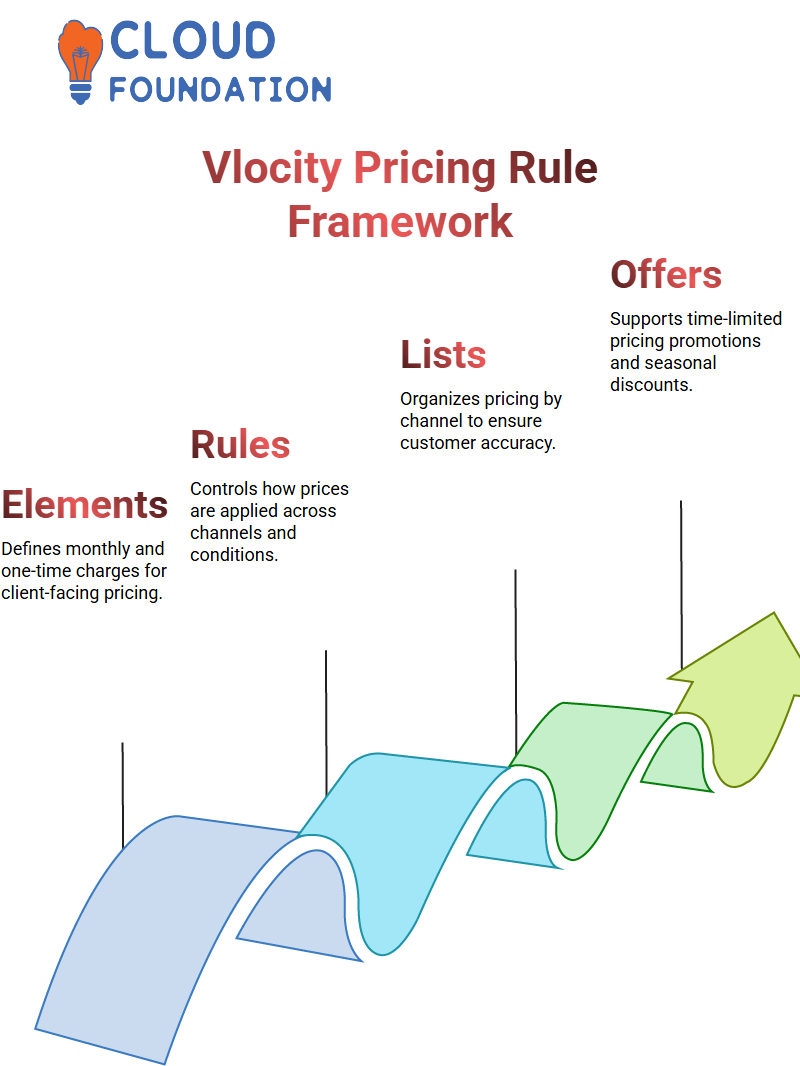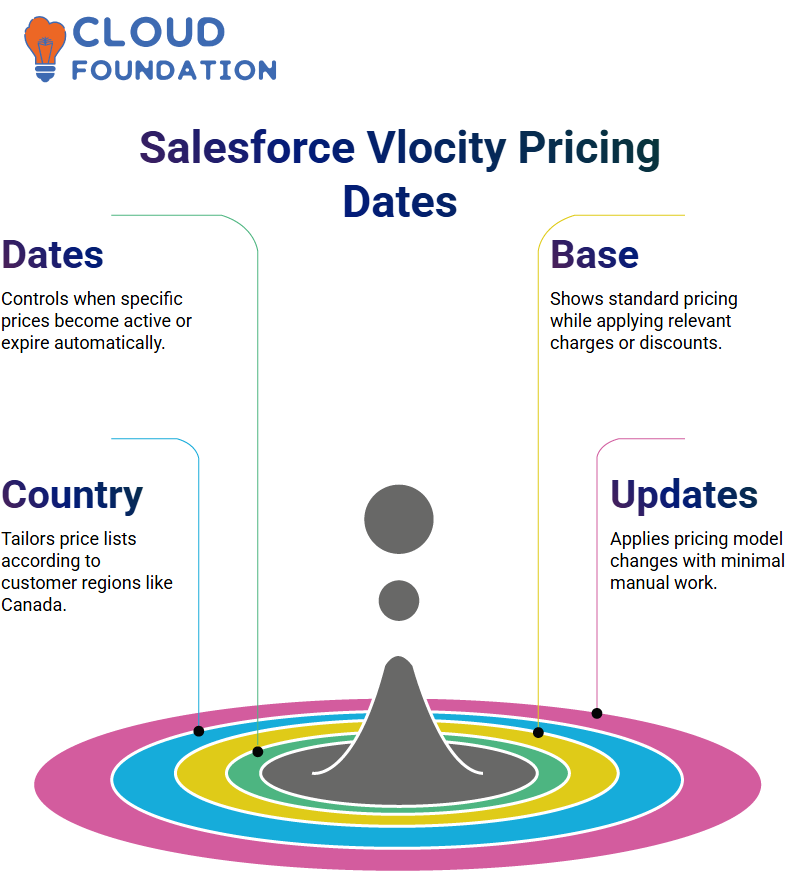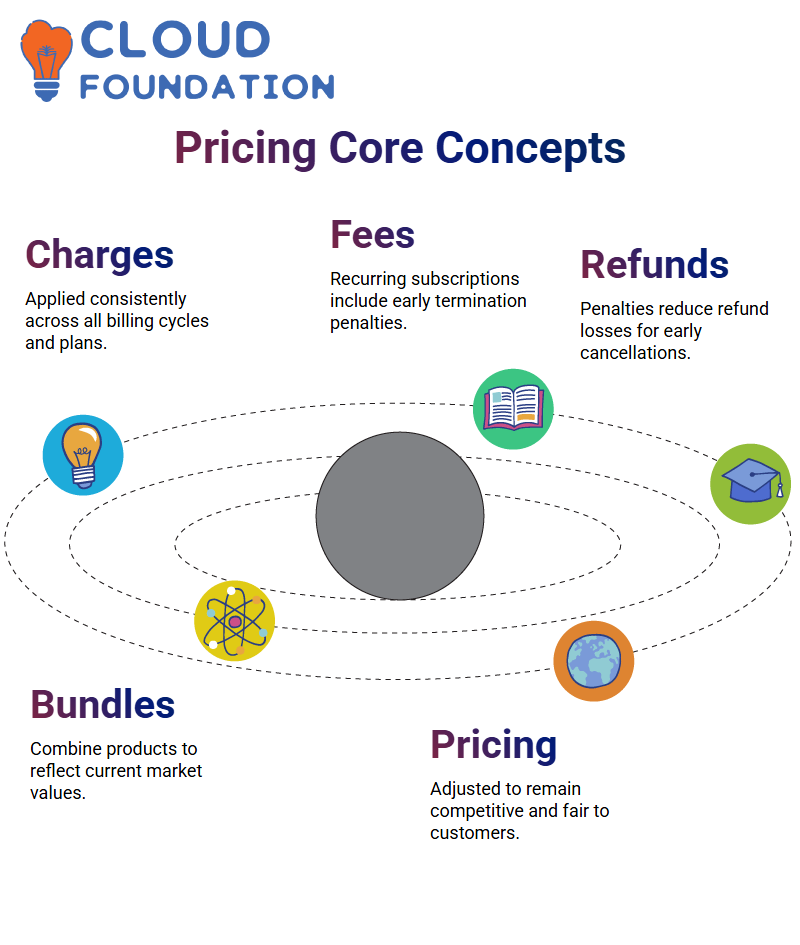Salesforce Vlocity Training on Pricing and Its Rules
Understanding Salesforce Vlocity
Salesforce Vlocity’s powerful tools offer businesses a range of options to customise product eligibility and compatibility for external platforms, streamlining how products are displayed to customers.
Salesforce Vlocity’s advanced tools enable businesses to tailor their offerings to meet customer demands and geographical availability, thereby achieving this crucial objective.
Understanding Salesforce Vlocity Pricing
Pricing plays a crucial role in Salesforce Vlocity. When setting prices for services or products, we need a structured method for defining where prices originate and their evolution over time.

Salesforce Vlocity’s pricing elements help allocate costs efficiently.
Cost estimation can be tricky when considering various bundles, especially when trying to determine costs across scenarios. We will outline here how pricing works and shifts according to different situations.
Salesforce Vlocity’s list price serves as the foundation for accurate calculations when managing parent and child products, as well as for bundling strategies.
However, understanding price adjustments helps ensure that accurate calculations are performed.
Salesforce Vlocity offers a flexible pricing framework tailored to a range of business requirements, whether working with standard products or custom velocity elements, providing smooth transactions.
Price books play an indispensable part in Salesforce Vlocity for businesses. They enable companies to set region-specific pricing structures, guaranteeing products have accurate costs across markets.
In contrast with traditional pricing models, Vlocity separates product from pricing to give businesses greater flexibility.
Defining Pricing in Salesforce Vlocity
Salesforce Vlocity is a flexible pricing system. Using Salesforce Vlocity, set base prices, recurring charges, or even placeholder values as needed.
Salesforce Vlocity makes setting prices or fees intuitive and straightforward. Run background jobs using TPMT administration to ensure that my prices appear in the cart, ensuring that price updates are seamlessly reflected in customer views.
Salesforce Vlocity Pricing Strategy
Pricing management within Salesforce Vlocity can be a complex undertaking, and understanding the interactions between elements is crucial for efficiently structuring price lists that inherit essential features from parent lists.
Vlocity enables us to efficiently structure price lists while still inheriting necessary items from parent lists, ensuring seamless pricing management.
Setting pricing elements requires categorising them based on group roll-ups, one-time adjustments and absolute values. Salesforce Vlocity streamlines this process by automating pricing definitions for businesses.
Salesforce Vlocity’s inheritable pricing elements feature is an effective and straightforward method for assigning each pricing variable with ease, significantly decreasing manual effort while increasing efficiency.
Automation plays an essential role in this process. By using Salesforce Vlocity, businesses can dynamically set up price lists according to customer preferences. Inheriting properties from parent price lists reduces redundant tasks and streamlines configuration.
Businesses using Salesforce Vlocity for pricing strategies can leverage predetermined rules when setting pricing strategies, whether offering percentage-based discounts or flat-rate reductions, providing businesses with precise control over pricing decisions.
Understanding how Salesforce Vlocity structures price books and entries is crucial for businesses aiming to optimise their revenue models. Adjusting these elements enables companies to offer competitive pricing without compromising profitability.
Salesforce Vlocity offers businesses incredible pricing flexibility by enabling them to customise price books, price lists, discounts, and time-based adjustments for effective pricing strategies and limited-time offers.
Salesforce’s platform also allows businesses to manage costs more effectively by providing access to robust cost and revenue analytics tools that optimise revenue management capabilities.
Pricing Elements in Salesforce Vlocity
Salesforce Vlocity enables businesses to develop and administer pricing elements efficiently. From monthly charges to one-off fees, this tool ensures pricing structures are clearly outlined for clients.
By configuring pricing elements, businesses can avoid overlapping charges and remain consistent in their pricing strategy. Salesforce Vlocity’s tools make this task simpler.
Understanding Salesforce Vlocity Pricing Rules
Pricing rules are essential when working with Salesforce Vlocity and should be set correctly to ensure smooth implementation.
One key element of Salesforce Vlocity is effectively managing price lists.

When adding, for instance, an iPhone to the cart, different pricing rules apply based on the channel; our website channel price list ensures that customers who order through this channel receive accurate prices.
How Salesforce Vlocity Handles Price Rules
With Salesforce Vlocity’s flexible pricing rules, pricing rules adapt with business needs rather than remaining static. Price rules can also be set for specific durations to provide flexibility during promotional offers.
One key advantage of Salesforce Vlocity is the seamless integration between configurations and product-level operations.
Price Lists in Salesforce Vlocity
Salesforce Vlocity enables businesses to easily create multiple price lists for various customer segments or regions.
For instance, creating pricing plans explicitly tailored for California customers can differ from those tailored for Nevada or Dallas clients. This flexibility helps ensure pricing strategies align with market needs.

Businesses using Salesforce Vlocity can control how pricing appears in the cart by setting the base price to zero, ensuring that unintended charges do not occur and maintaining pricing accuracy and transparency. This feature helps maintain pricing accuracy and transparency.
Creating B2C Price Lists in Salesforce Vlocity
Salesforce Vlocity supports multiple B2C price lists, giving businesses flexibility in tailoring pricing for different customer segments. Be it standard prices or promotional offers, Salesforce Vlocity ensures accurate application.
Businesses can easily set prices based on either recurring charges or one-time payments, with Salesforce Vlocity providing businesses the power to set pricing variables that meet both business needs and customer expectations.
Flat-Rate Pricing and Discounts in Salesforce Vlocity
Salesforce Vlocity enables flexible pricing structures with flat-rate discounts. Where each child product receives an incremental reduction, bringing down the overall costs to create an even lower final bill.
By making strategic adjustments to their offers, businesses can devise attractive offers, such as a recurring discount or a free pricing override for special promotions, creating tailor-made pricing strategies within Salesforce Vlocity.
Dynamic Pricing with Salesforce Vlocity
One of Salesforce Vlocity’s many impressive capabilities is dynamic price modification.
For instance, when sold solo at $600, it might drop to $400 when packaged together as part of an offer. With such flexibility at hand, businesses can better tailor pricing according to different purchase scenarios and meet various market demands more effectively.
However, price adjustments don’t just apply to bundles; they also apply across periods. For instance, if want to offer limited-time discounts, set a price list with reduced pricing that only lasts 24 hours at a time.
Managing Time-Based Pricing in Salesforce Vlocity
Time-based policies in Salesforce Vlocity ensure that your prices remain unchanged, regardless of market fluctuations, until the renewal time arrives, providing customers with peace of mind during this critical purchase decision period.
Telecommunications prices often change over time; what was once available at $400 may now cost $600 due to market shifts. With Salesforce Vlocity’s pricing framework, customers who have already subscribed for the long term won’t be affected by these fluctuations.
Date and Base Pricing in Salesforce Vlocity
The pricing expirations and updates in Salesforce Vlocity. You can set an effective date that determines when specific prices remain valid.

Base pricing is another key element of Salesforce Vlocity, ensuring customers see the appropriate cost on product pages while also accommodating adjustments through additional charges or discounts.
This ensures they always see what was intended by you, while dynamic discounts or premium add-ons may apply automatically through Salesforce Vlocity.
Country-Based Pricing in Salesforce Vlocity
Salesforce Vlocity enables us to differentiate pricing based on the customer’s location within their region. For instance, a price list can be created specifically for customers in Canada while still adhering to the general pricing structures for other areas.
Salesforce Vlocity streamlines pricing by leveraging object types to enable the inheritance of pricing attributes, thereby creating an automated mechanism that accommodates country-specific variations without requiring manual recreation of every element.
Web Channel Pricing in Salesforce Vlocity
Salesforce Vlocity enables us to design structured pricing mechanisms with ease via multiple price lists. Discounts may apply depending on the customer’s type; existing customers may see different prices than those who take advantage of promotional discounts.
One key concept here is the originating channel. When orders originate on the web, specific pricing rules take effect automatically to apply an accurate web channel price list to every online order.

Context dimensions in Salesforce Vlocity provide the means of linking these values with pricing rules, assigning rules to rule sets that determine price actions. Qualifying products or applying discounts are managed efficiently in this platform.
Salesforce Vlocity for Seamless Pricing Configuration
Salesforce Vlocity simplifies the management of complex pricing configurations by making dynamic adjustments easier, thereby providing better transparency and efficiency in business practices.
Working with Salesforce Vlocity makes adjustments simple: tweak pricing according to specific conditions while overrides allow for complete overhauls of the structure altogether. This ensures customers experience consistent pricing without surprises along the way.
Price Changes and Existing Orders in Salesforce Vlocity
Changes in price lists often raise concerns regarding existing orders that have already been placed, yet Salesforce Vlocity makes this a non-issue.
Salesforce Vlocity makes setting plans easier by acting as if we signed an agreement with each customer and respecting our costs together, helping to ensure trust between parties while keeping operational matters transparent.
Salesforce Vlocity Pricing Assurance
Setting up recurring subscription products on Salesforce Vlocity requires specifying both the purchase date and duration. By providing an end date, Salesforce Vlocity ensures that the same price remains through that time.
Customers and potential subscribers alike frequently, regarding any price changes to active subscriptions, is how a new pricing update affects current subscriptions.
With Salesforce Vlocity, however, any price updates do not affect existing plans; their price remains fixed, as per the policy chosen when the purchase was made, to ensure consistent treatment for both the customer and the company alike.
Recurring Charges in Salesforce Vlocity
Recurring charges are an integral component of Salesforce Vlocity pricing. Salesforce Vlocity ensures charges are applied consistently throughout.
Businesses can configure pricing elements with repeating charges to match their billing cycles and stay profitable with consistent charge application.
Subscription Fees in Salesforce Vlocity
Subscription fees are at the core of Salesforce Vlocity pricing. Should a customer cancel early without following our policies, Salesforce Vlocity applies an early termination penalty fee as part of our compliance procedures.
 Salesforce Vlocity enables businesses to more effectively manage refunds while maintaining stable revenue by deducting a percentage as penalties when customers cancel subscriptions , thereby minimising refund costs and keeping revenue streams consistent.
Salesforce Vlocity enables businesses to more effectively manage refunds while maintaining stable revenue by deducting a percentage as penalties when customers cancel subscriptions , thereby minimising refund costs and keeping revenue streams consistent.
Product Bundles in Salesforce Vlocity
Product bundles are an indispensable feature of Salesforce Vlocity. As technology advances and the value of electronic goods declines over time, Salesforce Vlocity enables businesses to adjust pricing in response to market demands.
Salesforce Vlocity enables businesses to reflect changes in an iPhone’s price compared to last year in their pricing strategy, ensuring customers receive fair pricing.
The businesses remain competitive in their marketplace. By doing this, companies ensure that customers receive fair pricing, while customers enjoy fair service from them.
Product Compatibility in Salesforce Vlocity
Salesforce Vlocity provides product recommendations tailored to each customer, based on their purchase history and personal preferences, thereby enhancing the user experience and driving sales.
Organisations using advanced configurations of Salesforce Vlocity can easily and effortlessly set eligibility criteria for products, whether by customer tier or geographic region. With Salesforce Vlocity’s seamless control capabilities, businesses have complete oversight.
Context Dimensions in Salesforce Vlocity
Context dimensions in Salesforce Vlocity define pricing rules based on various conditions. For instance, different pricing rules may exist for B2B transactions versus consumer sales transactions.
Web orders also follow specific discounting criteria defined beforehand.
Once we establish the necessary context dimensions, we assign values to them that serve as triggers for specific pricing mechanisms, ensuring customers receive appropriate discounts based on their eligibility.

Salesforce Vlocity enables dynamic pricing strategies with flexibility in mind. Seasonal promotions, new customer discounts, and special offers can all be seamlessly implemented within the system.
With proper configuration of context actions, pricing rules can adjust dynamically based on conditions set within them.
Optimising Pricing with Salesforce Vlocity
Salesforce Vlocity transforms pricing management by integrating automated pricing rules, flexible adjustments, and dynamic charge cycles.
Businesses are empowered with this powerful pricing management solution to efficiently control all aspects of pricing, from promotional discounts to recurring fees, saving time and resources while remaining compliant.
Salesforce Vlocity enables organisations to easily develop customised pricing plans, lock rates for specified durations, and adjust pricing based on regional or business needs, all without creating unnecessary complexity in operations and ensuring customer satisfaction with predictable pricing plans.
This enables smooth operations while enhancing customer satisfaction through predictable pricing.
E-commerce with Salesforce Vlocity
Salesforce Vlocity plays a pivotal role in connecting external shopping platforms to internal product data and providing customers with up-to-date pricing and availability information.
Businesses using Salesforce Vlocity can therefore ensure customers always receive accurate prices and availability details.
Salesforce Vlocity enables businesses to integrate product data from Salesforce into external platforms via APIs, allowing even non-logged-in users to browse available offerings before making their purchase decisions.
Salesforce Vlocity Product Configuration for Seamless Experiences
Salesforce Vlocity enables businesses to tailor their product associations based on user-defined criteria using JSON structures, thereby offering personalised experiences to customers.
Companies can create configurable options within Salesforce Vlocity to define specific criteria that define product associations.
Using configurable options, organisations can define product associations based on specific criteria that define associations for particular products or product attributes they wish to associate.

Vinitha Indhukuri
Author



